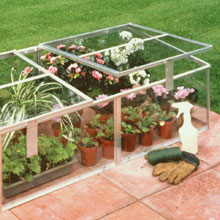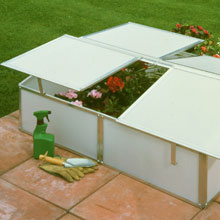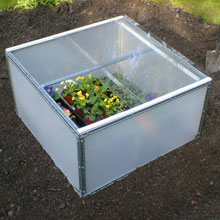.jpg)
How to overwinter tender plants in a cold frame
If you love to use tender or tropical plants in your garden but don't know what to do with them come autumn, a cold frame provides a simple solution.
How to overwinter tender plants in a cold frame
If you love to use tender or tropical plants in your garden but don't know what to do with them come autumn, a cold frame provides a simple solution.
Simply put, it's not a greenhouse, and you won't be able to keep your plants growing lushly and looking wonderful throughout the winter months - but you will be able to provide those plants with the right conditions during their dormant season so that, come spring, they will be ready to leap into action once again and resume healthy growth.
A sunken cold frame will prove to be the best insulated as the ground will naturally provide the most consistent temperature although other insulation materials such as horticultural fleece can help too.

To keep your tender perennials in a cold frame, cut them back as much as possible, without compromising the plant, before the first frosts. If the plant isn't already in a container then lift it, being very careful to keep the rootball intact, and then transplant it into a large pot that will comfortably accommodate the roots and a good surrounding of compost to protect them.
Pack the cold frame out with your pots and fill in any gaps with mulch or other insulation material, this can be dry leaves, or manmade material such as shredded paper or polystyrene. Water the pots and then cover the tops to help prevent drying out and to retain moisture around the roots. Composts and especially farmyard manure give off heat as they decompose and will make very effective insulation, although take care not to overheat the cold frame as this will spur your plants into growth far too early and could cause irreparable damage. Better to be safe than sorry.

Once the plants are all stored away in the cold frame, it is down to you to control the weather conditions inside. Make sure the pots never dry out but also avoid over-watering as this may cause the roots to rot. The plants aren't going to grow and so won't take in much water at all during this period. Keep the light levels low but not totally dark, adding a light layer of fleece over the plants will help limit the light getting to the plants and prevent them growing too early.

Fluctuations in temperature can also be harmful to dormant plants and should be kept to a minimum if possible. If the outside temperature is between 2 5 C then a tiny opening in the lid will help any excess heat escape, higher spikes in temperature may require you to open the lid further just remember to close it again before the temperature drops at night! Take a look on the site for our full range of cold frames.
Using a sunken cold frame or sitting it near to a windbreak will give your plants inside even better protection, this is particularly important if you have plants which retain their foliage over winter.

Written by: Graham Ward

I've been gardening for as long as I can remember, my first earliest memory being planting seeds in my Grandfather's prestige flower bed and having a prize lettuce growing there, which he proudly left to show everyone.
Since then, gaining knowledge and experience from both my Grandfather and my Father, I've continued to garden, both as a hobby and later on as a professional gardener and landscaper for 12 years. I love all aspects of it, from the design and build, to the planting out of summer borders with plants you've either grown from seed or raised from plugs. Unusual varieties always catch my eye and I'm keen to try growing them, even if sometimes it means learning from my mistakes.
Sign Up For Exclusive Special Offers




© 2024 Thompson & Morgan. All rights reserved. A division of Branded Garden Products Limited.



